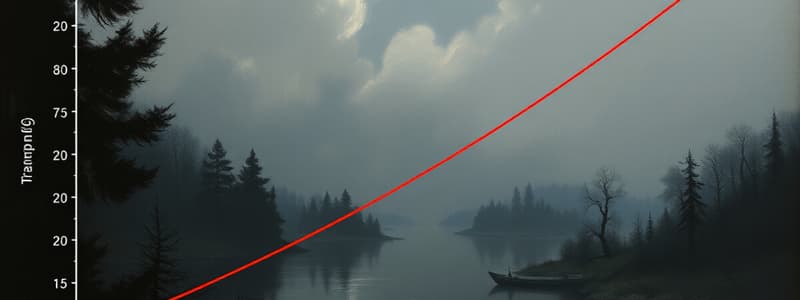Podcast
Questions and Answers
What is a scatter plot?
What is a scatter plot?
A graph used to determine whether there is a relationship between paired data.
What does correlation refer to?
What does correlation refer to?
The relationship between two data sets.
What is a line of fit?
What is a line of fit?
A model used to represent the trend in data showing a positive or negative correlation.
A positive correlation means that as one variable increases, the other variable decreases.
A positive correlation means that as one variable increases, the other variable decreases.
A negative correlation indicates that as one variable increases, the other decreases.
A negative correlation indicates that as one variable increases, the other decreases.
What does no correlation mean?
What does no correlation mean?
What are the steps to create a scatter plot?
What are the steps to create a scatter plot?
How do you solve a scatter plot equation?
How do you solve a scatter plot equation?
What is extrapolation?
What is extrapolation?
What is interpolation?
What is interpolation?
What are the steps to find a line of fit on a calculator?
What are the steps to find a line of fit on a calculator?
How do you determine if you are extrapolating or interpolating?
How do you determine if you are extrapolating or interpolating?
What is a positive correlation coefficient?
What is a positive correlation coefficient?
What indicates a negative correlation coefficient?
What indicates a negative correlation coefficient?
What is the correlation coefficient?
What is the correlation coefficient?
How do you solve a correlation coefficient equation?
How do you solve a correlation coefficient equation?
What is causation?
What is causation?
Flashcards are hidden until you start studying
Study Notes
Scatter Plots
- A scatter plot visualizes the relationship between paired data points.
- By plotting coordinates, one can observe potential trends or correlations.
Correlation
- The correlation describes the relationship between two data sets, indicating how they move in relation to one another.
Line of Fit
- A line of fit, or line of best fit, represents the trend of data, indicating either a positive or negative correlation.
Positive Correlation
- In positive correlation, as one variable increases, the other does too, resulting in an upward trajectory on the graph.
Negative Correlation
- Negative correlation occurs when one variable increases while the other decreases, leading to a downward slope.
No Correlation
- No correlation means there is no discernible relationship between the data sets, which cannot be effectively represented by a straight line.
Creating a Scatter Plot
- To create a scatter plot, plot the coordinate points, assess correlation, and draw a line fitting the data, ensuring roughly equal points lie above and below it.
Solving Scatter Plot Equations
- After calculating the slope, use any two points on the line to formulate an equation, ultimately converting it to the slope-intercept form ( y = mx + b ).
Extrapolation
- Extrapolation predicts values outside the original data range by utilizing the established model.
Interpolation
- Interpolation estimates values within the data range using the same model.
Finding Line of Fit on Calculator
- Use a calculator to find the line of fit by entering data into statistical lists, followed by executing a linear regression calculation to derive the equation.
Differentiating Extrapolation and Interpolation
- To distinguish between the two, analyze whether the question involves values within or outside the data range.
Positive Correlation Coefficient (C.C.)
- A positive correlation coefficient indicates a positive relationship, with ( r ) values ranging from 0 to 1; values close to 1 signify stronger correlations.
Negative Correlation Coefficient (C.C.)
- A negative correlation coefficient reflects a negative relationship, with ( r ) values spanning from -1 to 0; values closer to -1 show stronger negative correlations.
Correlation Coefficient
- The correlation coefficient, denoted as ( r ), quantifies the strength and direction of a linear relationship between two variables.
Solving Correlation Coefficient Equations
- To solve for correlation coefficients, calculate the line of fit using a calculator, balance ( r ) values according to correlation strength, and compare between variables.
Causation
- Causation refers to a scenario where one variable directly influences another; for instance, more hours worked results in higher pay.
Studying That Suits You
Use AI to generate personalized quizzes and flashcards to suit your learning preferences.




